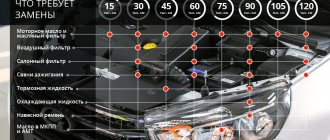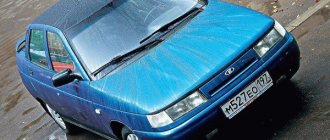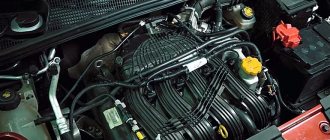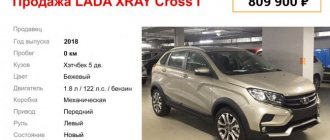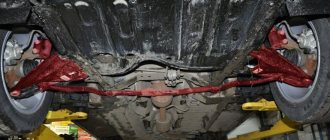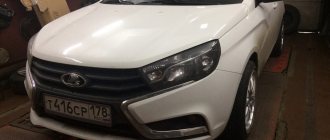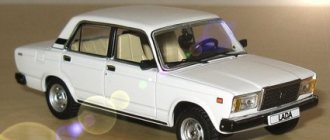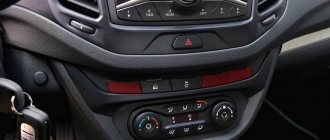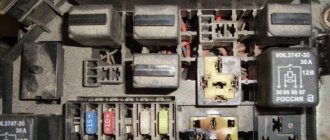June 27, 2021 Lada.Online 113 361 6
AVTOVAZ recommends performing maintenance (MOT) for vehicles of the LADA XRAY family every 15,000 km or every year (whichever comes first). It is also recommended that during the warranty period, maintenance be performed only at an official LADA dealer, with a mandatory note about the work being carried out in the service book coupons. It is worth noting that the maintenance regulations differ depending on the year of manufacture of the car.
Maintenance Lada Xray
SPECIAL OFFER!
Special conditions for corporate owners CLIENT REVIEWS Find out what our clients say about us
Lada Xray is a high hatchback in the SUV style of the Russian company AvtoVAZ. The compact crossover has been produced since 2015. A model with high off-road ground clearance, improved suspension and a dynamic engine. This car attracts attention with its expanded list of options and sculpted design.
The BARS-AUTO service center provides a full cycle of maintenance for Lada Xrey vehicles. Modern domestic and foreign equipment of our car service allows you to perform multidisciplinary diagnostics and not miss hidden problems. If any faults are found, our technicians are ready to carry out both minor and complex repairs. We also replace consumables according to the plan and requirements of the maintenance regulations for your machine. Our warehouse store sells the necessary spare parts and consumables for maintenance. Car owners have access to the repair area, and the staff will be happy to answer your questions. You can spend your waiting time in a cozy seating area watching TV or magazines.
We have fair pricing, maintenance strictly according to regulations, a large staff of specialists in various fields and a friendly attitude towards each client.
Do not forget that regular technical inspection is the key to long service life of your car!
| Mileage, thousand km | 15 | 30 | 45 | 60 | 75 | 90 | 105 | 120 |
| Months | 12 | 24 | 36 | 48 | 60 | 72 | 84 | 96 |
| THAT | TO-1 | TO-2 | TO-3 | TO-4 | TO-5 | TO-6 | TO-7 | TO-8 |
| Regulatory work | price, rub. | ||||||||
| Engine oil | 500 | 500 | 500 | 500 | 500 | 500 | 500 | 500 |
| Spark plug | 300 | 300 | 300 | 300 | ||||
| Cabin filter | 300 | 300 | 300 | 300 | 300 | 300 | 300 | 300 |
| Fuel filter | 1300 | |||||||
| Air filter | 200 | 200 | 200 | 200 | 200 | 200 | 200 | 200 |
| Brake fluid | 600 | 600 | ||||||
| Timing kit | 3500 | 3500 | ||||||
| Antifreeze | 600 | |||||||
| Diagnostics | 600 | 600 | 600 | 600 | 600 | 600 | 600 | 600 |
| Cost of work | 1600 | 1900 | 2200 | 5400 | 1600 | 3100 | 1600 | 6700 |
| Materials and spare parts | price, rub. | ||||||||
| Motor oil | 2600 | 2600 | 2600 | 2600 | 2600 | 2600 | 2600 | 2600 |
| Oil filter | 300 | 300 | 300 | 300 | 300 | 300 | 300 | 300 |
| Timing kit | 4800 | 4800 | ||||||
| Air filter | 700 | 700 | 700 | 700 | 700 | 700 | 700 | 700 |
| Fuel filter | 300 | |||||||
| Cabin filter | 700 | 700 | 700 | 700 | 700 | 700 | 700 | 700 |
| Candles (4pcs.) | 600 | 600 | 600 | 600 | ||||
| Antifreeze | 1100 | |||||||
| Brake fluid | 300 | 300 | ||||||
| lubricants | 200 | 200 | 200 | 200 | 200 | 200 | 200 | 200 |
| cost of labor | 4500 | 5100 | 4800 | 9900 | 4500 | 6500 | 4500 | 10200 |
| Maintenance cost | 6100 | 7000 | 7000 | 15300 | 6100 | 9600 | 6100 | 16900 |
- The cost of work does not include work according to the contract. crankcase protection
- the cost of maintenance may be indexed due to changes in the cost of spare parts
BARS-AUTO is a modern Lada Xray car service center in Moscow (Zelenograd), we carry out maintenance according to regulations
We counted and shed tears: the whole truth about the cost of Lada Xray maintenance
Were you going to buy a hatchback based on the penny Zhiguli cost of maintenance? We have to disappoint - the difference between the expected and actual price of routine maintenance turned out to be simply shocking.
Were you going to buy a Lada Xray with a Nissan engine, counting on the penny Zhiguli cost of maintenance? We understand, but we have to disappoint - the difference between the expected and actual price of routine maintenance turned out to be simply shocking.
All the efforts of the ex-director of AvtoVAZ, Bo Andersson, were aimed at distancing two Tolyatti new products - Lada Vesta and Xray (more about the hatchback here) - from everything that was previously produced at the plant, freeing the cars from the burden of a sad reputation. And we are talking not only about improving the quality of the product and production culture, but also about the overall feeling of the car. “Xray” and “Vesta” have become a pleasure to drive; they compete on an equal footing with bestsellers in the budget segment, and in some consumer properties they even surpass them.
In the new Ladas, nothing rattles, cracks or falls off anymore, although this was achieved largely through the widespread use of imported components. True, if Vesta was originally born with a Tolyatti engine under the hood, then the raised Xray hatchback began its market career with the foreign H4M engine, familiar from many models of the Renault-Nissan concern - starting with Sentra, Tiida and Juke and ending with Duster. In Tolyatti specification, a 1.6-liter engine with an aluminum block and timing chain drive develops 110 hp. (150 Nm), providing the Xray with manual acceleration to 100 km/h in 11.1 s and a top speed of 181 km/h.
Lada Xray with a 110-horsepower Renault-Nissan engine is now sold in a single configuration - with a 5-speed manual transmission in the TOP/Yubileinaya version.
Price 799 thousand rubles An AutoVesti correspondent uses this Lada Xray as a personal car, and there are no special complaints about the engine: the dynamics on the “handle” are sufficient, the average fuel consumption in Moscow traffic jams in winter does not exceed 8.6 liters, engine noise does not put pressure on the ears.
Here is what the manufacturer himself writes about the dynamics and comfort of the Lada Xray:
LADA XRAY is a comfortable and high seating position, especially convenient in the city and on light off-road conditions, a dynamic engine, sharp handling, good sound insulation. The car's suspension is tuned for active maneuvering: gas-filled shock absorbers and a front subframe provide excellent control over the road. High off-road ground clearance together with an energy-intensive, trouble-free chassis guarantee excellent cross-country ability.
Only today you can buy an Xray of that very “Bu-Andersson” era with a Renault-Nissan engine only in a single configuration - in order to reduce the cost, AvtoVAZ is gradually removing this unit from the list of hatchback engine range, replacing it with a Tolyatti 1.6-liter engine 106 hp with index 21129, which is installed on Vesta and is planned for Vesta Cross.
Characteristics of power units.
The engines intended for the Lada X-ray are also used on other AvtoVAZ models (Kalina 2, Priora, Granta, Vesta) and demonstrate reliability and a high level of performance indicators.
Engine VAZ-21129.
The VAZ engine 21129 was created as a modification of the famous engine 21127.
Among the important design changes that deserve attention:
- The use of flaps in the intake manifold that dynamically change its length. The result is obtaining an optimal mode at high and, partially, low.
- Replacing the mass air flow sensor with a pair that controls temperature and pressure. The modification is designed to improve control of the fuel-air mixture and eliminate instability at idle.
- Modernization of the exhaust system;
- Firmware change.
The latest improvements are designed to ensure compliance with Euro 5 emissions standards.
As a result, the power unit received the following characteristics:
- The arrangement of the cylinders in the block is in-line;
- Installation – transverse;
- Number of cylinders – 4;
- Number of valves -16 (4 valves per cylinder);
- Cylinder diameter - 82 mm;
- Piston stroke - 75.6 mm;
- Working volume - 1596 cc;
- Compression ratio – 10.7.
Fuel and lubricants:
- Type – gasoline, atmospheric;
- Recommended fuel is unleaded gasoline with an octane rating of 95 (for example, AI-95). Due to electronic settings, the use of 92 gasoline is allowed.
- Power supply – microprocessor-controlled injection system (injector);
- Amount of oil in the lubrication system – 3.5 l:
- Recommended lubricants - viscosity class according to SAE J30, depending on winter temperature, for most Russian territories - 5W-40, 10W-30, 10W-40, 15W-40.
- Oil consumption – 0.3% of fuel consumption.
- Fuel consumption on a Lada Xray with 5-speed manual gearbox per 100 km (urban / suburban / mixed cycle) - 9.3 / 5.9 / 7.0 l.
- Power (max) – 78 kW / 106 hp. at a rotation speed of 5800 rpm.
- Torque (max) – 148 Nm at a rotation speed of 4200 rpm.
Dynamics for Lada X-ray with 5-speed manual transmission:
- Maximum speed 172 km/h;
- Acceleration time when starting from a standstill to 100 km/h is 11.7 s.
Resource - 200 thousand kilometers.
Despite all the positive reviews, the engine has a significant drawback - it is rather weak for a heavy X-ray, as fuel consumption and dynamics indicators clearly indicate.
Lada XRay maintenance schedule
Regular maintenance of a Lada XRay car is a list of service works determined by the manufacturer, performed once a year or every 15,000 kilometers.
| Maintenance operation | 15000 km TO-1 | 30000 km TO-2 | 45000 km TO-3 | 60000 km TO-4 | 75000 km TO-5 | 90000 km TO-6 |
| Changing the engine oil and oil filter | + | + | + | + | + | + |
| Replacing the air filter | + | + | + | + | + | + |
| Replacing the cabin filter | – | + | – | + | – | + |
| Replacing spark plugs | – | + | – | + | – | + |
| Replacing brake fluid | – | – | + | – | – | + |
| Coolant replacement | – | – | – | – | – | + |
| Replacing the accessory drive belt | – | – | – | – | – | + |
| Replacing the timing belt | The timing belt is replaced at a mileage of 180,000 km | |||||
Inspection operations every 15,000 km
Engine checks
- Checking the absence of extraneous noise when the engine is running;
- Checking for engine oil leaks through seals and engine oil seals;
- Checking the functionality of the engine control system (if there are error codes);
- Checking the condition of the auxiliary drive belt;
- Checking the tightness of the exhaust system and the condition of the muffler suspension;
- Check for coolant leaks;
- Checking the condition of the hoses and radiator of the engine cooling system;
- Checking the coolant level in the tank;
- Checking the tightness of fuel pipelines and hoses;
- Checking the degree of tightening of the engine mounts;
Chassis checks
- Checking the absence of knocks and squeaks in the front and rear suspensions when driving over uneven surfaces;
- Check the condition of the front and rear suspension parts.
Transmission checks
- Checking the absence of extraneous sounds when engaging and disengaging the clutch (for manual transmission);
- Checking the clarity of gear shifting and the absence of extraneous noise when the gearbox is operating;
- Checking the absence of extraneous noise in the joints of the front wheel drives when driving in a straight line and in turns;
- Checking the oil level in the gearbox;
- Checking for leaks through the seals and oil seals of the gearbox;
- Checking the condition of the protective covers of the gear shift drive;
- Checking the condition of the protective covers of the front wheel drive joints.
Steering checks
- Checking the fluid level in the power steering electric pump reservoir;
- Checking the amount of play in the steering;
- Checking the condition of the steering rod boots and steering rack;
- Checking wheel alignment angles;
Brake system checks
- Checking the brake fluid level;
- Checking for brake fluid leaks;
- Checking the condition of brake system hoses and pipes;
- Checking and, if necessary, adjusting the position of the brake light switch;
- Checking the parking brake operation;
- Checking the effectiveness of the brakes;
- Checking the operation of the vacuum brake booster;
- Check the degree of wear of the front and rear brake pads.
Electrical equipment checks
- Checking the level and density of electrolyte in the battery;
- Checking the serviceability of the generator;
- Checking the operation of the windshield wipers;
- Checking the serviceability of the heated rear window;
- Checking the serviceability of heated seats;
- Checking the operation of electric windows and electric side mirrors;
- Checking the serviceability of lighting lamps, light alarms and sound signals;
- Checking the operation of the electric headlight corrector;
- Check and, if necessary, adjust headlights;
- Checking the serviceability of the climate control system (air conditioning).
Checking body elements
- Checking the serviceability of door and hood locks;
- Cleaning drainage holes in doors and thresholds;
- Lubricating hinges and door stops.
Inspection operations every 30,000 km
Performing all operations every 15,000 km, as well as:
- Checking the condition of tires and rims;
- Check and, if necessary, balance wheels.
Inspection operations every 45,000 km
Performing all operations every 15,000 km, as well as:
- Remove the brake drum and check the condition of the rear brake pads and drum;
- Lubricating the hood lock drive cable.
Inspection operations every 105,000 km
Performing all operations every 15,000 km, as well as:
- Checking the technical condition of the timing belt, guide and tension rollers
In the spring, we were the first to cross the Russian state border behind the wheel of an XRAY. Well, now we are ahead of everyone in terms of completion of TO-1: none of the crossovers sold have yet traveled the required 15,000 km. Immediately after the scheduled maintenance, with fresh oil and filters, we decided to measure the power of our XRAY.
To be fair, it must be said that due to some circumstances I had to undergo maintenance a little earlier - with a mileage of about 14,250 km. The official regulations establish the following intervals: 14,500–15,500 km or one year of operation. But at the technical center where we went for servicing, they already know dromomobiles well (there, first, the white Vesta underwent maintenance and the first warranty repair of the suspension, and then XRAY showed up with suspicious knocks), so they were lenient with us, agreeing to service the car with less mileage. True, 14,516 km were written in the service book - so that in the event of another maintenance or warranty repair at another dealer, that dealer would not have any complaints. Thank you.
Another nuance immediately became clear: when talking with a service employee by phone to make an appointment for maintenance (by the way, they made an appointment in a day, quite quickly), they told me the cost of 10,694 rubles. But it turned out that this is how much maintenance costs for a car with a VAZ engine. Servicing an XRAY with a Nissan “heart” is a little more expensive. In this case, this difference, again, at the suggestion of the receiving master, was leveled out by “discounts”. That is, we paid the agreed upon 10,694 rubles, although for an ordinary owner of an XRAY with a 110-horsepower engine, the amount will be increased by about 1,900 rubles. True, this takes into account an additional liter of oil (480 rubles). The fact is that no one at the dealership knew the capacity of the Nissan engine, so just in case, they wrote out five liters in the order instead of the standard four for the VAZ unit. In the end, it turned out that this engine also contains exactly four liters. So now I have a “litrushka” of the same “synthetics” “Rosneft” for topping up.
It can be seen that the first maintenance mark indicates a mileage of 14,516 km instead of the actual 14,250 km. The pre-agreed amount for TO-1 was met thanks to discounts (column “discount”). If you add up all the amounts in this column, you get 1887.21 rubles. We must assume that this is exactly how much (minus the cost of a liter of oil 480 rubles) that TO-1 will cost more for owners of XRAY with a Renault-Nissan engine
This “multi-company” was in my package after TO-1: cabin filter - Lada, oil - Rosneft, air filter - Renault and oil filter - Nissan!
The master inspector, taking the car from me, said that our XRAY, as it is actively used and the first to come in for maintenance, will be inspected especially carefully. Well, I don't mind waiting an extra half hour for X to be taken apart. It’s a pity that in a small area of the dealership center we were not able to simulate the situation with the appearance of a strange hum in the engine. Well there is no way. In terms of dynamics, there are no complaints about XRAY yet. On the contrary, the car was properly run in and driven around.
Strange engine noise
In the last post, I talked about how XRAY began to suffer from barely noticeable dips in speed. In fact, these are not even failures, but some kind of wave-like specific engine hum that I had not noticed before. It appears at rpm above 3700 and only under load (for example, with passengers or driving uphill). Looking ahead, we can say that, most likely, these are some features of an already run-in engine: after all, the XRAY showed itself to be a great guy on the dyno!
Exactly 2 hours later, a clean car was returned to me and all the consumables were replaced. Summary of the mechanics and the master: our XRAY is in excellent shape, no “jambs” were found, the maintenance went without any questions or hiccups. By the way, just before the visit to the technical center, the seal on the front edge of the hood came off. I deliberately did not say anything at the reception. As a result, after maintenance the seal turned out to be glued. Nice.
The hood seal was simply poorly glued. You can see how more dust and dirt immediately began to “suck” under it. And this is in the summerWell, since they say that the car is in perfect order, the filters and oil have been changed, it’s time to find out whether the Nissan engine produces the declared 110 “power” and 150 Nm? Moreover, the mileage is just under 15,000 km: XRAY is “at its best.” The search for a dyno did not take much time, and on the same day I was in Zelenograd, near Moscow, where the very hospitable guys from City Customs agreed to take measurements of the “new product from AvtoVAZ.”
Dyno stand
The American SuperFlow dyno can measure the power of all-wheel drive vehicles. The drums are connected to each other, so the rear wheels of even front-wheel drive cars (as in our case) also rotate. In front there is a huge cooling fan. The guys don’t have an exhaust system for venting exhaust gases outside, but there is enough ventilation.
The car stands on drums and is pulled in front and behind by thick slings. A small adjustment of the position (the steering wheel should be straight so that the car doesn’t want to slide off the “treadmill”), tighten again, and you’re ready to go! A technician with a special remote control sits in the driver’s seat, from which he controls the stand, I go to a safe zone (behind a special metal shield), a giant fan turns on with a wild howl, and, standing still, XRAY begins its “acceleration”.
It is best to carry out tests in the gear that is closest to straight line. In the JH3 gearbox installed on the XRAY, this is the fourth (gear ratio - 1.029). The tester instantly reaches the desired stage - the resistance of the drums is minimal - and with a roar and howl the engine reaches close to maximum speed. Oh, if only “X” really accelerated so quickly!
We carried out several necessary measurements. I was glad that all this was finally over, because being in a room where it howls and rumbles as if it’s about to rip the roof off the building is not very pleasant or comfortable. You can see how the car is pulled to attention, being “crucified” by slings and with its wheels spinning wildly. The spectacle is spectacular, but quickly gets boring.
The atmosphere at CityCustoms is spartan, but everything you need for measurements is here. The middle photo shows the same graph that SuperFlow produced, thereby indicating the maximum power of our XRAY at 114.9 hp. at 5200–5700 rpm and maximum torque of 151 Nm at 4000 rpmBut I won’t torment you any longer, because everyone still wants to find out as soon as possible whether the Renault-Nissan engine is getting its money’s worth? In my opinion - completely: I repeat once again that there are no questions about the dynamics of “X-Ray”. Taking into account its design and power supply, of course. According to the dynamometer data, the engine output even exceeded the declared one, although not by much. So - fanfare! - the engine of our XRAY turned out to be almost 5 horsepower more powerful, and the torque was 1 Nm higher - 115 hp. and 151 Nm ! As they say, it’s nothing, but it’s nice.
After completing the measurements and analyzing all the graphs, the technicians reported the same thing that the inspection master at the dealership had told me hours earlier: the car (in this case, its engine) is in excellent shape. But do you see the little squiggles in the graph around 5000 rpm? Perhaps this is the same hum that I have been hearing lately. There are still minor interruptions. The reason, apparently, could be both the throttle valve and the spark plugs. As long as we continue to drive like this, it causes almost no inconvenience.
My personal summary of the XRAY with a mileage of 15,000 km and quite harsh operation is as follows: the car holds up well and endures all the hardships and hardships. Those petty problems that crop up from time to time seem ridiculous to the former owner of Lada. So far - without any serious damage. We continue monitoring.
Best regards, Dmitry Krotov
PS Tire punctured
List of works during maintenance of TO-3
Published by: Andrey Demchenko in Repair 12/12/2016 0 2,209 Views
Lada XRAY is a new product on the Russian market, which has deservedly aroused great interest among buyers; this is due, first of all, to two factors: modern body design and high-quality assembly based on imported components. To carry out warranty maintenance, the AvtoVAZ concern has issued a manual for dealers containing a list of works. It would be interesting to get *a review from a real owner* on the third XRAY maintenance; it is carried out for cars with a total mileage of 45 thousand km.
Please note that the manufacturer's recommendations for warranty service for Lada XRAY require regular and repeated technical inspection after a certain mileage, after 15 thousand km, 30 thousand km, 45 thousand km, 90 thousand km, 105 thousand km and 180 thousand. km. Accordingly, the list of work at the third inspection (TO3 or TO45) will include routine maintenance related to warranty service after 15 thousand km and 45 thousand km.
For Lada XRAY owners, it will be good news that the manufacturer has included much more routine maintenance than is provided by other car companies as part of the warranty. In other words, AvtoVAZ is trying to attract buyers not only with higher-quality cars of the new line, but also with “premium” class technical service. Today, owners speak positively about both the car and the warranty technical service provided by official dealers.
Within the framework of TO45, the entire list of works according to TO15 is carried out, relating to the functionality of the main systems, and replacement of wear components for cars with such mileage is carried out. Please note that the dealer may refuse free service if the car owner has violated the maintenance schedule.
Introductory section
This part of the instructions contains general information about the purpose of the car, the permissible conditions of its operation, the obligation to perform annual maintenance in accordance with the items in the service book, as well as information about official AvtoVAZ dealers and the features of the registration documentation of re-exported crossovers.
- Keys, doors, windows and pedals
The section contains rules for using car keys, door electrical equipment, light signaling levers and window washing and cleaning, as well as an overview of the pedal location area depending on the type of transmission.
- Seats, passive safety systems
Under this heading, a detailed description of the equipment, seat adjustments and use of the heated front seats is provided. The section, according to the title, also contains information on passive safety systems - the location, functions and proper use of head restraints, belts, airbags and child seats.
- Instrument panel, controls
The section contains a specification, as well as a visual representation of the location of all devices and their controls located on the front panel:
- instrument panel with decoding of information elements;
- adjustable steering wheel angle and steering wheel controls;
- control of electric drives of external rear view mirrors.
- Driving and driving
This part of the instructions contains the basic provisions, recommendations for driving, managing and servicing the vehicle in order to ensure safe operation and the vehicle resource declared by the manufacturer.
- Correction and driving assistance system
Under this heading, the instructions contain information about the operation of the cruise control, speed limiter and safe parking systems. Familiarization with the section will allow you to objectively assess the degree of need to use these options and disable them in certain situations.
- Heating, ventilation and air conditioning of the interior
The section describes the functions of the Lada Xray of the same name - the layout, location of heating, ventilation and air conditioning controls for the rational and effective use of various modes of these options. The functions are responsible not only for the comfortable conditions in the cabin, but also for visibility (elimination of glass fogging and frosting of exterior mirrors).
- Interior lighting and vehicle comfort
This part of the instructions contains information about the location of lighting devices, emergency calls in manual and automatic modes, and comfort accessories in the cabin and trunk.
- Car care
This part of the instructions introduces the daily or periodic tasks that the car owner has to perform during the operation of the Lada XRay - access to the engine compartment, monitoring of working fluids and the condition of the battery, layout of fuses in the block, maintenance of headlights and exterior mirrors, paint care body coating and much more, which is impossible to do without.
- Practical advice
The section contains operating instructions that are not only advisory in nature, deviation from which does not entail serious consequences for the Lada X Rey. For example, tire sizes are limited to specific values, and the characteristics of usable wheels and mounting bolts have even more stringent limits.
Following these tips will make it easier to maintain, repair and operate your vehicle, as well as save time and extend the service life of components.
- Vehicle specifications
The content of this part of the instructions does not require comment - the section contains all the data necessary both for the first acquaintance with the car and for servicing it throughout its entire service life, including the location of the vehicle identification number (VIN) and the rules for reading it.
- Applications
The information in this section is difficult to overestimate; it contains requirements for engine oil, spark plugs and lamps of the Lada X-Ray - consumables directly related to the service life of the car and the safety of its operation.
Engine
After the car has traveled 45 thousand km, the shortcomings of the car can already accumulate and make themselves felt. Therefore, you should not only undergo the third inspection from a bona fide dealer, but also be attentive to the “symptoms” of the car yourself. The technical list of works, as recommended by the manufacturer, for inspecting and troubleshooting engine problems includes visual inspection, checking gaskets and functionality, and troubleshooting.
List of third maintenance works related to the engine:
- The oil filter and engine oil need to be replaced;
- The air filter is changed due to wear;
- a visual inspection of the engine is carried out and tested for extraneous sounds;
- the supports and their degree of tightening are checked;
- all kinds of leaks through oil seals and engine oil seals are monitored;
- error codes are read and the engine control system is tested;
- structural elements are checked and tested for leaks (exhaust systems and muffler suspension);
- check the tension and condition of the timing belt;
- the damage to the belt for auxiliary elements and the degree of its tension are checked;
- checked for leaks in the cooling system, and also inspected hoses and other elements of the engine cooler;
- a visual inspection is carried out and the coolant level in the tank is monitored;
- All elements of fuel hoses and pipelines are tested for leaks.
- check the amount of oil in the gearbox;
- checked for loose seals and gearbox seals;
- the protective covers of the drive and its hinges for the front wheels are inspected;
- the physical parameters of the electrolyte in the installed battery are checked;
- the generator is tested for malfunctions;
- The battery leads and terminals are cleaned and lubricated.
List of works during maintenance 1 (15,000 km or 1 year)
- Changing the engine oil. The oil filling volume in an engine equipped with a manual transmission is 4.4 liters, and in an engine with an AMT it is supposed to be filled in 3.2 liters. It is recommended to use ROSNEFT Maximum 5W-40 motor oil, catalog number 4 l. canisters - 4291, and price - 900 rubles .
Checks during maintenance 1 and all subsequent ones:
- crankcase ventilation system;
- hoses and connections of the cooling system;
- coolant;
- exhaust system;
- fuel lines and connections;
- covers for joints of different angular velocities;
- checking the technical condition of front suspension parts;
- checking the technical condition of rear suspension parts;
- tightening the threaded connections securing the chassis to the body;
- condition of tires and air pressure in them;
- wheel alignment angles;
- steering gear;
- checking the free play (play) of the steering wheel;
- hydraulic brake pipelines and their connections;
- pads, discs and drums of wheel brake mechanisms;
- vacuum booster;
- parking brake;
- brake fluid;
- checking the drive belt;
- checking the timing belt;
- accumulator battery;
- spark plug;
- headlight adjustment;
- locks, hinges, hood latch, lubrication of body fittings;
- cleaning drainage holes;
Transmission and chassis
The main load from a car's mileage is taken by its chassis, so special attention is paid to its inspection and preventive repair.
List of works of the third XRAY maintenance for chassis and transmission:
- visual inspection and dynamic testing for abnormal sounds in the clutch (when on/off);
- it is necessary to check the gearbox shifting and ensure normal operation, including monitoring for abnormal noises and sounds;
- check for excess noise from the front-wheel drive joints while driving on the road and when cornering;
- check for sounds and knocks in both suspensions, including on uneven road surfaces and off-road conditions;
- checking wheel alignment and wheel mounting angles;
- At the stand, the front and rear suspension is inspected for wear and defects.
Brake system
The braking system is the key to safe driving, so it needs constant attention and testing. After passing 45 thousand km, on the recommendation of AvtoVAZ, the official dealer must carry out the following list of works:
- the brake system is inspected for brake fluid leaks from pipes and hoses;
- the effectiveness and serviceability of the hand brake is checked;
- the brake fluid in the hydraulic drive is checked and changed, its condition and the required volume is filled;
- The vacuum booster is tested;
- The brake pads are inspected and the level of wear is determined (this applies to the rear and front pads).
- the brake drum is dismantled and its condition and pads are checked;
Body
Lada XRAY body maintenance work includes the following list of services:
- doors and functional elements - hinges and stops - are lubricated;
- the operation of the glass cleaners and washers is checked;
- the operation of the heated front (optional) and rear windows is checked;
- window regulators and external mirrors are inspected;
- the locks on the doors and hood are checked;
- The door drainage and thresholds are cleaned.
- The hood lock drive cable is lubricated.
Zero maintenance. Extras. Impression.
Good afternoon everyone.
So the summer passed, as if it had never happened. The mileage on the X-ray is 4100 km, with a little.
In August, zero maintenance was completed (at 2,500 km), during which screens were installed in front of the radiator to prevent fluff, leaves and other debris. They are almost invisible from the outside, because... They are located behind the radiator grille, so I didn’t take pictures. The asking price is 1600 rubles. The oil was replaced with Shell 5w-40. Then I ordered deflectors for the doors. In general, I wanted to buy and install them myself, otherwise the price in the showroom was too high - 3,300 rubles including installation. You can order on the Internet for 1200 – 1500 rubles. I was confused by the reviews I came across in which people complained about their poor quality, some even fixed the edges with self-tapping screws. During installation in the salon, the master confirmed that they, too, initially bought cheaper ones, but there were returns from customers, because... The deflectors (especially the front ones) simply came off. Even super glues didn't help. It turned out that the previous supplier had goods with warped surfaces. They began to take something more expensive, but of higher quality, and the refusals went away. Let's see if it seems to be holding up for now.
After running-in, I began to allow an increase in engine speed and speed. No, of course, the X-ray is far from the fastest car, but it suits me quite well. The 1.8 engine is powerful and allows you to overtake on the highway even in fifth gear. And when going uphill, you don’t always have to switch to lower gears; a simple hill can be pulled out in 5th. Gasoline consumption in the city is around 10 liters, outside the city - about 8. Not little, perhaps you need to change your driving style to a more uniform one.
The first time, going out into nature, I was very careful, afraid of hitting something with the bottom or bumper on the rocky Ural paths. Still, this is not my old Niva Chevrolet, which relaxed me completely. But so far everything is fine with the X-ray, I’m skating more and more boldly on the rough roads. Once again I appreciated the convenience of my own homemade organizer (well, how can I not brag). All the small things that are not needed right now lie under the raised floor in the cells and do not interfere “above”. I throw various things on top, without fear of pushing through the floor. The main thing, when packing for your next trip, is not to forget to move the essentials into the main compartment ahead of time, so as not to throw things out of the trunk when getting to the underground for some shovel.
Everything is working normally. There was one moment in July that made me nervous. The weather was hot but cloudy. While parking in the morning at work, I noticed wet tracks that led under the bottom of my car. I got out, looked and was shocked - there was an unpleasant puddle under the car on the asphalt near the driver’s seat. I touched it and it didn’t seem like oil. And it continues to drip. I crawled under the hood and checked what I could, visually and using the probes. All fluids are in place (in the sense of being at normal levels). I signed up for the service by phone and drove there after work. I stopped at the service center and it was dripping under the bottom. The master came out and looked, touched, and smelled: “Are there any other complaints?” No, but isn't that enough? He says: “So this is condensation from the air conditioner, this is normal.” Why didn't this happen before? The weather is like this, hot and humid, the condensation does not have time to evaporate and drips down a special groove, the instructions say about this. I read about condensate in the instructions, but I didn’t think that it could be in such quantities.
What do you like about the car? Much. More (compared to Niva) high-torque engine. Energy-intensive suspension. Convenient interior transformation. High ground clearance. Electronic assistants - I’m very used to the rear view camera, I almost never look in the mirrors when parking. Convenient climate system - I turn it on mainly in the “Auto” mode. Of course, you can do without some of them (to reduce the price of the car). But, if they are available and functioning, then it is simply convenient. Let's say a rain sensor. It seems like a small thing, you can turn on the wipers yourself. But then an oncoming dump truck passes by, sprays dirty water on the windshield, and you are distracted from the road. And then once, the wipers turned on themselves, and you are no longer blind, conveniently. The multimedia system is not bad. Of course, there are questions about it in terms of improvements, but I’m already used to using my smartphone remotely, all calls and the phone book are on the screen. You can listen to music directly from your phone without any cords. I like the way the front seats are heated - the heating periodically increases/decreases itself, so the heat level is in the comfort zone. Heating control raises questions, but this is already a disadvantage.
Yes, there are also disadvantages, unfortunately. Without them. The same heated seats, or rather the heating on/off buttons. In Niva and Vesta they are located in the center console area, equipped with light indication, the likelihood of forgetting to turn them off is much less. Why were they hidden in blind spots in Xray? Unclear.
I'm getting used to the short 1st and 2nd gears, but for me they are inconvenient. I tried to start in 2nd. Not a very comfortable feeling, it seems that the engine is working with more strain, although the car seems to be moving.
The side mirrors are large, but they are apparently slightly convex; the distance to the cars behind them is increased. I have already mentioned this as a feature of the machine. Now I think this is a drawback. You can fight it, but it would be better not to have it.
Perhaps there are no more shortcomings. Let's ride on.
Getting ready for winter. I ordered Michelin X-ize Nord 3. 185/65R15 tires, these are studs.
PS
I went out into the parking lot this morning, the front and rear windows were covered in frost, the first light frost. Minus 1. The first thought is that you need to look for a glass scraper. Then I started it up and pressed the “Max” button on the climate control panel. Two minutes later the front and rear windows became wet, I waved the wipers and off I went. Great!
Bye everyone!
Salon
At the XRAY salon during the third maintenance they check:
- heated seats;
- working condition of climate control and air conditioning.
As you can see, in TO45 only three additional processes are carried out: replacing the brake fluid, checking the brake system drum and lubricating the lock drive cable. The rest of the list concerns TO15. It is also obvious that if there is serious damage, the official dealer will not provide free warranty repairs. This note especially applies to people who have an extreme driving style - the warranty will not help, you will have to pay for the restoration of the Lada XRAY.
Probably, the manufacturer is counting on providing preventive service, rather than carrying out actual repair work within the warranty period, since the technical regulations mainly concern the inspection and testing of the functionality of individual machine systems. Accordingly, if problems arise after a decent mileage, it is worth additionally contacting the service with specific complaints, without expecting them to be resolved during maintenance.
Lada XRAY Ray-Robot 1.8 › Logbook › Preparation for TO1, materiel or how to stand above your soul on the matter.
Hi all!
It's no secret that maintenance in salons costs a lot of money.
For example, the cost of work on a Lada XRAY is about 3,500 rubles. And the regulations include a sufficient amount of work. However, it is no secret to anyone. That “enough work” often comes down to washing and changing oil and filters in 10 minutes. And the car stood in the corner of the service area for another 3 hours. In this case, money is paid, but the work is not performed. Most people are happy with this. They are content to watch the car through a monitor and pay money for non-existent work. There is a second type of people. Which stand above the soul of the master and require completely unrealistic and mysterious work that is not included in the regulations. Or they give valuable advice to the master. In order to give the right advice and control the completeness of the paid maintenance, you need to know the regulations and be in the repair area - at the same time, do not interfere with the foreman’s work
, but point out any shortcomings identified during the work.
Remember, the master, like any person, may miss something, accidentally or not, but you paid the full amount and have the right to demand high-quality work.
You can read how to reduce maintenance costs here.
I will try to give advice on how to undergo maintenance for the XRAY fret. We will need the factory technical manual, which can be found on the Internet, and a little patience to read it, I will attach the link at the end. I will present the main operations in a compressed format that need to be performed on TO1. If you are interested, you can read how to do them and the regulations for all maintenance by downloading the document.
Necessary checks during maintenance 1:
• Condition of front and rear suspension elements, CV joint covers. • Tightness of seals of components and assemblies • Tightness of the exhaust gas exhaust system • Operation of locks of front and rear doors, hood, tailgate • Operation of the fuel tank hatch cover and reliability of fixation of the fuel tank filler cap • Tightness of seals of components and assemblies (in the engine compartment), tightness and the condition of the pads and brake mechanisms, hoses and cooling system. • Levels and color of liquids • Operability of electrical equipment components (lamps, correctors, mirrors, etc.) • Integrity of the windshield and rear-view mirrors • Condition of the auxiliary drive belt • Condition of the battery (mounting, voltage, density, amount of electrolyte) • Availability of caps wheel valves • Fault codes for vehicle electronic systems and fault indications.
Replace during maintenance 1:
• Replace the oil filter and oil in the engine crankcase. • Replace the cabin and engine air filter element.
Lubricate during maintenance 1:
• Rubbing areas of opening limiters and door axles, axle and springs of the fuel tank hatch cover, locking mechanism.
Inspect the body during maintenance1: • Check the condition of the body and make an entry in the service book about the presence or absence of damage to the paintwork and anti-noise mastic, indicating the date and signature of the contractor. For the most part, for a normal mechanic to check, it is enough to look at the car and the engine on a lift to identify 90% of all the listed issues and damages.
You can change the oil and filters in 30 minutes, along with lubricating the doors and locks. Inspecting the body is also not difficult. Therefore, after the warranty expires, or there is no interest in the warranty, but with at least one hand and desire, all this work can be done independently in less than an hour.
You can learn how to carry out these and other operations by downloading the manual from the link.
